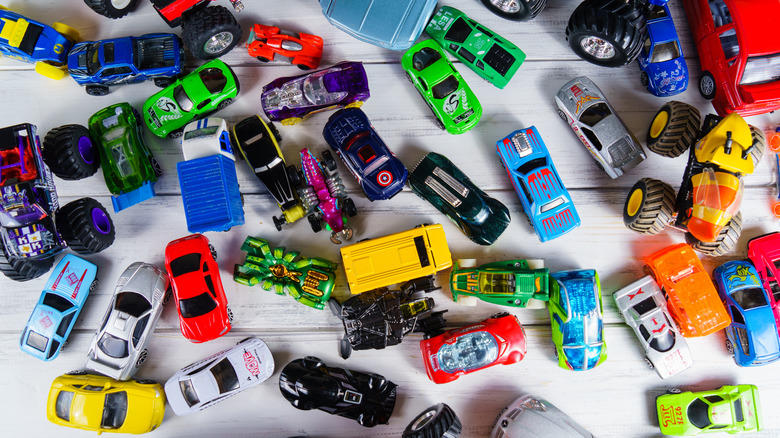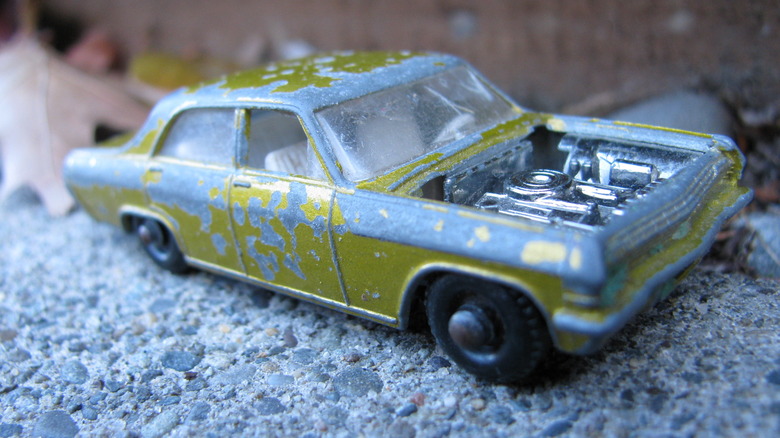5 Matchbox Cars Worth Way More Than You Can Imagine
We may receive a commission on purchases made from links.
Matchbox was making tiny die-cast cars more than a decade before Hot Wheels rolled onto the scene. It might be even more surprising to learn the first one was made for a girl, not a boy.
In 1947, Englishmen and Royal Navy war buddies Leslie Smith and Rodney Smith (no relation), along with business partner Jack Odell, formed Lesney Products, an industrial die-casting company. While they didn't start off making tiny die-cast toys, they soon received an order to make parts for a toy gun.
The following year (1948), they made their first toy based on a road roller (used to compress soil, gravel, concrete, etc.). When not building toys, they continued manufacturing things like the Lesney Bread Bait Press, a device fishermen used to make bait from two small pieces of bread.
Then, in 1952, Odell learned that his daughter's school allowed students to bring toys as long as they fit inside a matchbox. They shrunk down their big road roller toy until it fit neatly inside a postwar British matchbox ... and the rest is history. In 1996, Mattel Inc. (makers of Hot Wheels) bought Matchbox (and Tyco Toys Inc.) in a $755-million stock deal. Over 500 million Matchboxes have been made since '53, and more than 40 million are still produced yearly, equating to almost one million a week. Matchbox continues to sell its toy cars on Amazon, among other retailers.
As with most collectibles (not to mention some old tech you may have lying around), certain versions can be worth a fortune. Here are five die-cast dandies you can take to the bank.
1967 Apple-Green Mercedes Benz 230SL
The value of Matchbox cars usually boils down to a few things: the condition of the vehicle, whether you have the original box it came in, the production year made, and any variants it might exhibit (i.e., reversed colors, factory errors, color variations, limited run, etc.).
In 1966, Lensey released a 230 SL Mercedes-Benz (series 27d) with a white body and red interior. This was converted to a white Superfast edition (again with red seats) in 1970. The following year (1971), it came out with a yellow body (keeping the red seats), but later that year changed over to a black interior. Again, these cars in and of themselves aren't worth much.
But then there's the mystery of the apple-green body with a red interior. Oddly, this color variant isn't on any official Matchbox list of released vehicles, and even the scale is up for debate, with some sources claiming it a 1:60 while others 1:75. Virtually nothing else is known about it, including how it came to be or how many were released. It has since been pegged as a 1967 prototype or pre-production model.
What is known is that in 1999, it sold for $6,765 and has not been seen in public since. Though you'll probably never get your hands on this rare model, Matchbox does sell a newer version of its Mercedes 230 SL toy car.
1966 Turquoise Opel Diplomat
In 1966, the die-cast car company released a rather plain-looking Opel Diplomat sedan (series 36), based on a model from the automaker acquired by GM in the 1920s. The body was painted gold, had a black interior, and the words "OPEL DIPLOMAT" stamped on the baseplate. This version is readily available on auction sites and can be had for about $40.
The following year (1967), Matchbox released several different versions of its G-2 Transporter set that included a diesel truck hauler that could "transport" all of the tiny autos (usually four) that came with it. One very limited version of that gift set included a turquoise (aka sea green or seafoam green) Opel Diplomat that today is considered one of Matchbox's "holy grail" cars thanks to its rarity.
The body color isn't the only thing different about this Opel. While ordinary gold Opel's engine and baseplate were black, the turquoise version had a grey baseplate and motor. Back in 2018, the Detroit Free Press listed this car as having a value of $6,682, but other Matchbox hobby sites have since stated that on the rare occasion that you find one for sale, it has gone for as much as $9,000.
Though Matchbox doesn't appear to have the Diplomat model in its current line up, it does currently sell tiny versions of the 1975 Opel Kadett in orange and the 2022 Opel Astra in yellow.
1965 Reverse Color BP Dodge Wrecker
Errors created during the production of something are always highly coveted by collectors. They don't necessarily even need to be manufacturing errors, per se. Fleer released a Cal Ripken card in 1989 that clearly showed a derogatory "F" word on the bottom of the bat Ripken held, while a Topps Star Wars trading card from 1977 shows a morphed bodily appendage on C-3PO. However these "errors" made through quality control and got printed tends to drive the value of an otherwise mundane item to incredible heights. The same can be said for the reversed color found on Matchbox's "error" BP Dodge Wrecker.
In 1965, Matchbox dropped the Wrecker (series 13) with a yellow front cab and a green bed. But then some started popping up with the colors reversed (green cab, yellow bed). No one seems to know how many exist, if they're actual factory errors, or if they were instead test versions or prototypes that somehow managed to get into the production stream by accident. An MIB (Mint In Box) version sold in 2005 for $9,500. Another one sold in 2013 via eBay for $8,499. Meanwhile, the Detroit Free Press put the value of this BP-branded tow truck at $5,911 in 2018.
Present-day Matchbox fans may not be able to find one of these ultra-rare Dodge toys, but Matchbox does sell a different option for enthusiasts: a miniature 1998 GMC Wrecker.
1961 Light Brown Magirus Deutz Crane
This 1961 mini Magirus Deutz Crane had a grey/silver body with an orange boom crane. It's commonly referred to as the No. 30 crane because it comes from series 30-B. By the time it was discontinued in '65, at least 27 variations existed. Again, like many other Matchbox cars, it isn't exceptionally valuable, even with the original box included, and can be had from auction sites for less than $100.
The pre-production version, though, is a different story entirely. It sports a light brown (some call it tan) body and has either an orange or red crane arm. Only two are known to exist.
A CNN Money article from 2004 states that in the late 1980s, collector Charlie Mack found what sounds like a light brown Magirus Deutz Crane at a garage sale and paid $10 for it. A few years later, he sold it in an online auction for $10,000. In that same CNN piece, Jim Gallegos (a famous toy car collector) claimed to have one of these gems in his collection and that it was worth $13,000.
However, the article also states that the No. 30 crane was from 1968, which is inaccurate because the toy was discontinued in 1965. Further complicating the appraisal, the Detroit Free Press had it as the second most valuable die-cast car (at $11,822) on their list from 2018. All of this shows how misinformation propagation continues to surround these antique toy cars to this day. Fans looking for a modern alternative to this classic can check out Matchbox's Mobile Crane.
Major Quarry Truck
This die-cast car defies the diminutive size of the previous vehicles on the list. At 11 inches long, the yellow Quarry Truck was supposed to be part of the Major series collection, which allowed for greater detail but couldn't fit inside a matchbox like the one in the video above. Many claim this is both the rarest Matchbox car in existence and the most valuable. It is the true Holy Grail of Matchbox cars.
The company never put the actual truck into production. However, chief model maker Ken Wetton built between six and eight prototypes. Lesney Products intended to sell these much bigger vehicles at Christmas, but the plan never came to fruition. It kept one in-house as a souvenir while the rest of the prototypes disappeared.
Then, in the mid-1980s, Japanese Matchbox car collector Mr. Takuo Yoshise bought the lone Quarry Truck from Lesney for an undisclosed amount. After having it in his collection for a quarter of a century, Yoshise thought it was time for a new generation of collectors to enjoy the one-off and sold the truck at the 25th Annual Matchbox Club convention in 2010 for $15,000.

